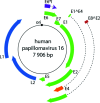ICTV Virus Taxonomy Profile: Papillomaviridae
- PMID: 29927370
- PMCID: PMC6171710
- DOI: 10.1099/jgv.0.001105
ICTV Virus Taxonomy Profile: Papillomaviridae
Abstract
The Papillomaviridae is a family of small, non-enveloped viruses with double-stranded DNA genomes of 5 748 to 8 607 bp. Their classification is based on pairwise nucleotide sequence identity across the L1 open reading frame. Members of the Papillomaviridae primarily infect mucosal and keratinised epithelia, and have been isolated from fish, reptiles, birds and mammals. Despite a long co-evolutionary history with their hosts, some papillomaviruses are pathogens of their natural host species. This is a summary of the International Committee on Taxonomy of Viruses (ICTV) Report on the taxonomy of the Papillomaviridae, which is available at http://www.ictv.global/report/papillomaviridae.
Keywords: ICTV Report; Papillomaviridae; taxonomy.
Conflict of interest statement
The authors declare that there are no conflicts of interest.
Figures


References
Publication types
MeSH terms
Grants and funding
LinkOut - more resources
Full Text Sources
Other Literature Sources

